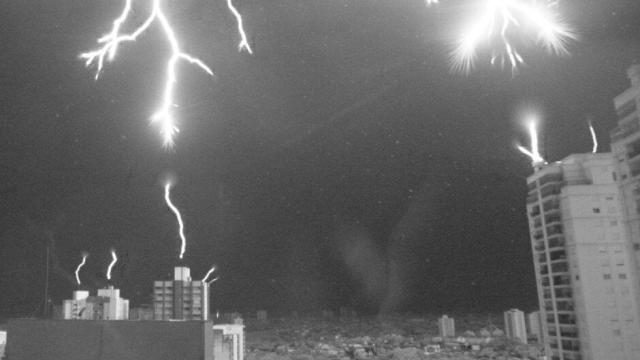A high-speed photo of lightning rods at work during an electrical storm in São José dos Campos, Brazil, is helping scientists understand how the devices compete to attract strikes and keep buildings safe from damage.
The image shows a lightning bolt heading towards the ground at 370 km per second, according to the researchers. Their analysis of the lightning rods’ reactions to the bolt was published in the Geophysical Research Letters in December 2022.
When the bolt was a hundred or so feet from the ground, “lightning rods and tall objects on the tops of nearby buildings produced positive upward discharges, competing to connect to the downward strike,” said study lead author Marcelo Saba, a researcher at Brazil’s National Space Research Institute, in a FAPESP release.
“The final image prior to the connection was obtained 25 thousandths of a second before the lightning hit one of the buildings,” Saba added.
Lightning rods were invented in the mid-18th century by Benjamin Franklin. They’re metal (often copper) used to safely disperse electrical discharges on the ground, according to Britannica, rather than letting them hit structures which easily could ignite. (Luckily for Mr. Franklin, lightning may have been less common then than it is today.)
Despite the 30-plus lightning rods in the imaged area, Saba said that a flaw in their installation allowed the lightning to strike a smokestack, causing a 30,000-amp discharge which damaged the structure.
Lightning seeks the path of least resistance towards the ground, not the most direct route, hence its trademark zig-zag shape. That’s also why it’s just as happy discharging on an unfortunate smokestack as it is landing on a lightning rod.
Lightning is basically an electrical spark in the atmosphere. As noted by NOAA, when there are significant opposite charges in the atmosphere, the air loses its insulating properties and the air sparks with lightning. (This is why you don’t need a thunderstorm for lightning to occur; it can also emerge from volcanic eruptions and nuclear explosions.)
In the image, one can see lightning rods on at least three different buildings attempting to connect to the downward lightning discharge. As the lightning shoots downward from the sky, the various rods and tall objects produce upward charges to connect with the bolts.
You could try 40,000 times to get this same photo, but you still couldn’t compete with the 40,000 frame-per-second camera. Besides a quick science lesson, it’s a hair-raising spectacle.
More: Record-Breaking Lightning Just Chilled in the Sky for 17 Seconds
